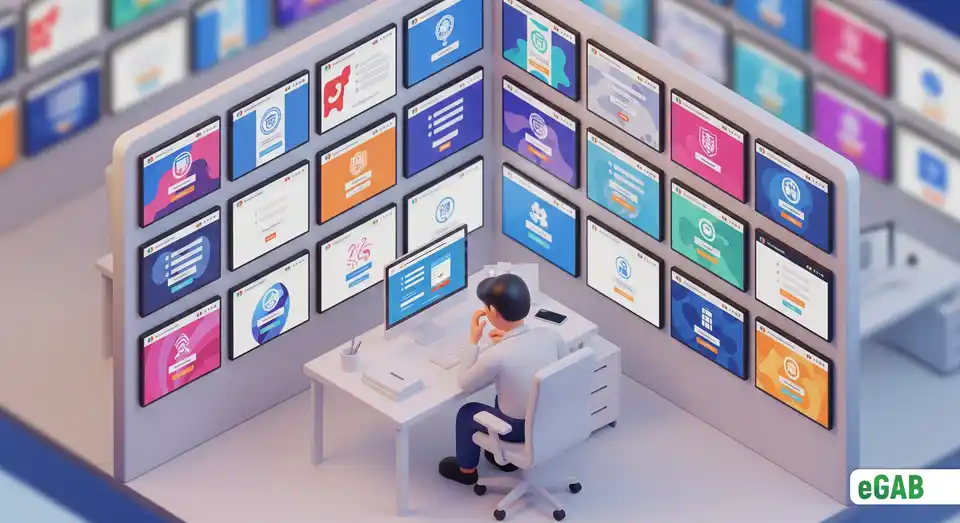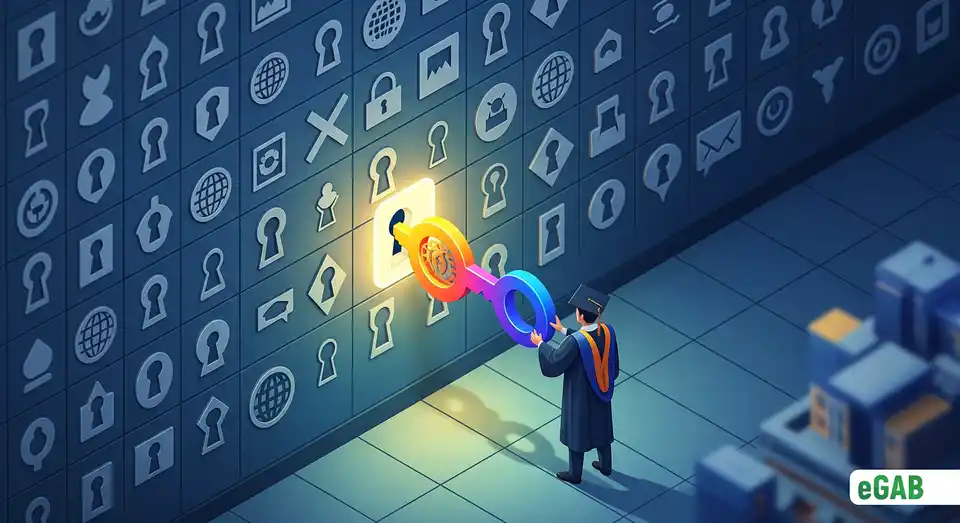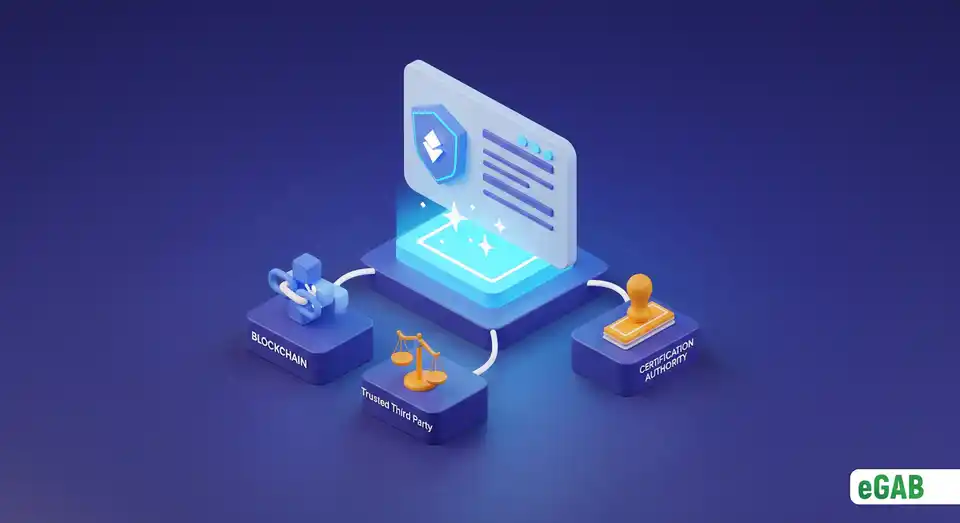Why an In-House Credential Verification System Is a Mistake for Universities

 Author:
Artem Grigoriev
Author:
Artem Grigoriev
- What Is the "Trust Paradox" in Self-Hosted Verification?
- How Do In-House Portals Create Inefficient Digital Silos?
- Why Do Proprietary Systems Lack True Interoperability?
- What Are the Hidden Costs of Building and Maintaining a Custom Portal?
- What Are the Proven Advantages of a Shared, Third-Party Ecosystem?
- The Best Alternative to an In-House Credential Verification System
- Summary: Escaping the Silo for a Future of Global Trust
For any forward-thinking university, building a custom portal to issue and verify digital credentials can look like a brilliant move. On the surface, it promises total control and a sleek, branded experience for your graduates. But what if this path actually creates more problems than it solves? Even with the best intentions, it's a route that can lead you dangerously off course.
Here’s the fundamental flaw with an in-house credential verification system : you end up building a beautiful, high-walled garden that no one else can easily access or trust. Why? Because it completely lacks impartial third-party validation .
The result? Instead of building bridges for your graduates, you're creating isolated digital silos . This approach doesn't just create frustration-it exposes your institution to significant cybersecurity risks and a complete lack of interoperability . In this article, we'll break down the critical mistakes universities make when they go it alone, from the staggering hidden costs to the "Trust Paradox." We'll also show you why joining a shared ecosystem is the only way to truly future-proof your graduates' hard-earned achievements.
📘 This post is part of our comprehensive guide to "The Problems with Paper Documents: A Complete Guide". Explore it to find answers to all your questions ;)
What Is the "Trust Paradox" in Self-Hosted Verification?
Your university has a stellar reputation, and of course, you're a trusted institution. But let's pause and ask a critical question: should an employer halfway across the world really have to trust you to verify your own documents, especially with no outside oversight? This very question is the heart of what we call the "Trust Paradox," and answering it reveals the fundamental problems with self-hosted verification .
Building your own verification system might feel like a leap into the future, but in reality, you're just digitizing an old, broken model. You're still asking employers and other schools to simply take your word for it. This brings up the obvious question: Why is third-party verification more trusted than in-house? Because a self-hosted approach leaves a massive vulnerability wide open. It’s missing the one thing that truly matters for global recognition: impartial, third-party validation from a neutral, independent organization.
You’re essentially asking the world to trust your internal database, but you aren't offering the independent, cryptographic proof (a secure, mathematical way to confirm authenticity) that modern systems demand. Let's be honest: that credibility gap gets even wider when you factor in the other major risks. So, what are the risks of an in-house credential portal? You have to worry about persistent cybersecurity risks , potential system failures, and the constant threat of a major data breach . In fact, some isolated systems have shown shockingly high error rates. This isn't just a small glitch-it’s a critical weakness that devalues your graduates' credentials. It also feeds a massive global problem: the multi-billion-dollar fake degree market. For institutions focused on preventing diploma fraud, this is a battle you simply can't win alone. Alarmingly, some reports even suggest there are more fake degree providers online than actual UK universities. The HEDD UK Annual Fraud Report makes it clear just how sophisticated the world of diploma mill / degree fraud has become. This sobering reality makes robust, independent verification more critical than ever before.
Why It Matters: In today's hyper-digital world, trust isn't built on a '.edu' web address. It's built on undeniable, independently confirmed proof. A self-hosted system might give you a digital signature, but a shared, third-party ecosystem delivers cryptographic certainty-a level of trust that can stand up to scrutiny anywhere on the planet.

How Do In-House Portals Create Inefficient Digital Silos?
So, what happens when every university decides to build its own verification system? You don't get a streamlined digital future. Instead, you create hundreds of isolated "islands of data." These are the classic disadvantages of proprietary university portals . This patchwork approach creates a fragmented and deeply inefficient mess that frustrates the very people you're trying to help-we're talking about employers, accreditation bodies, and especially your graduates.
And you don't have to take our word for it-the data speaks for itself. The American Association of Collegiate Registrars and Admissions Officers (AACRAO) found that while schools are eager to go digital, the lack of a unified solution is creating isolated digital silos (systems that can't talk to each other) instead of the connected shared ecosystem we all need. The AACRAO's research on the state of Comprehensive Learner Records points to one main culprit: a lack of standardization.
Just imagine you're an HR manager trying to hire graduates from five different universities. To do your job, you have to learn five completely different portals, each with its own login, interface, and verification process. That's not innovation; it's a logistical nightmare that becomes the digital equivalent of the bottleneck created by paper-based processes. Without proper API integration , these systems will always be isolated. It's a massive step backward, and it's exactly what experts call "technology dissonance from incompatible systems."
Takeaway: Technology should build bridges, not walls. An effective digital credentialing system must be part of an interconnected network that allows for seamless, one-click verification. Creating hundreds of separate portals that can't talk to each other just makes everyone's job harder.

Why Do Proprietary Systems Lack True Interoperability?
So, what is credential interoperability , and why does it matter so much to your students? Let's be blunt: most in-house verification systems are just closed gardens. They're built on proprietary code and private databases, so they were never designed to "talk" to any other system. They simply can't integrate with the global standards that are now defining the future of digital credentials. This complete lack of interoperability -the power for different systems to communicate seamlessly-creates a huge roadblock for your graduates who need to compete in a borderless world. This idea of openness is central to frameworks like the W3C Verifiable Credentials Data Model . These emerging W3C standards are building the future with formats like verifiable credentials (VCs) and the Comprehensive Learner Record (CLR) -formats that proprietary systems just can't handle.
And don't think this is a minor technical problem. UNESCO reports that millions of students are internationally mobile, out of more than 264 million enrolled in higher education worldwide. In a world like this, isolated, single-institution solutions just don't cut it anymore. True cross-border credential recognition isn't a 'nice-to-have' feature; it's absolutely essential. A credential loses a huge amount of its value when it can't be easily verified across different countries and platforms. The consequences are real. Study after study shows that the global recognition of their qualifications is a top priority for international students. When you lock your credentials inside your university's private ecosystem, you're crippling their portability. Ultimately, you're putting your graduates at a serious disadvantage in the global job market.
Quick Insight: Interoperability isn't just a tech buzzword-it's your graduates' passport to a global career. A credential that isn't interoperable is like a key that only opens their old dorm room door but is useless anywhere else in the world.

What Are the Hidden Costs of Building and Maintaining a Custom Portal?
On the surface, building your own verification portal seems like a great idea because it promises total control. Deciding to create an in-house credential verification system puts you right in the middle of the classic build vs buy verification software dilemma. The reality, however, is that this path is loaded with hidden costs that can quickly drain your budget and pull precious resources away from your main mission: education. It’s not unlike the true cost of paper-based workflows. Before you commit, you have to ask: How much does it cost to build a university verification system? The initial sticker shock comes from the cost of building a custom verification system through software development. For a secure, enterprise-level platform, you could easily be looking at a bill anywhere from $50,000 to over $1,000,000 .
But here’s the real kicker that most people overlook: the people. Industry benchmarks show a surprising truth: personnel costs typically eat up a staggering 60-80% of the total system development budget . That means a massive, long-term commitment from your internal IT talent. And the spending doesn't stop at launch. The portal needs constant security updates and penetration testing (simulated cyberattacks to find weak spots) to fight off ever-present cyber threats, which can add another $5,000 to $20,000+ every single year. This long-term resource drain from server maintenance, data privacy compliance, and user support really adds up. In the end, it almost always turns out to be far more expensive than joining a specialized, shared ecosystem built to handle all of this for you at scale.
Next Step: Before you even think about committing to an in-house build, do the math. You need to calculate the Total Cost of Ownership (TCO) , which is the full financial hit of a purchase over its entire life. Don't just look at the initial development price; you must factor in at least five years of maintenance, security, personnel, and compliance costs. The final number will likely make a very strong case for a smarter, shared solution.

What Are the Proven Advantages of a Shared, Third-Party Ecosystem?
Moving away from a flawed in-house model to a shared, third-party ecosystem is an incredibly smart move. You're not just avoiding problems; you're unlocking some serious advantages. Think of these networks as third-party academic verification services that do all the heavy lifting for you. This approach delivers the crucial independent validation needed to solve the "Trust Paradox," bringing real, measurable benefits to your institution, your students, and employers alike.
And the results speak for themselves. Institutions that switch to standardized, easily verifiable digital credentials earn significantly higher employer trust . They also see a big jump in their appeal to tech-savvy students, who expect modern solutions from leading digital credential platforms for higher education .
The efficiency gains are just as striking. Automated verification systems built on blockchain (a secure, decentralized digital ledger) are up to 75% faster than clunky manual processes or disconnected portals, setting a new gold standard for secure online degree validation . In the real world, this means modern shared systems can process around 1,000 verifications per hour through an API (a way for different software programs to communicate). This is the future of university degree verification . Meanwhile, older, isolated models that rely on someone manually looking up a record can't manage even a fraction of that. This leap in speed and trust gives you a powerful competitive edge, helping you attract the best students and employers.
Did You Know? The speed and trust you gain from a shared verification ecosystem are powerful because they directly enhance your institution's brand. When employers can verify a graduate's credentials in seconds, not weeks, your university builds a reputation for being modern, efficient, and forward-thinking.

The Best Alternative to an In-House Credential Verification System
So, what are the alternatives to a self-hosted verification system? The smartest, most secure, and future-proof choice is to join a complete, shared network for issuing digital credentials . This also answers another key question: What is the best platform for digital credentials? The perfect example is eGAB (The Global Academic Blockchain Ecosystem for Digital Credentials) . It's crucial to understand that this isn't just another piece of software; it’s a full ecosystem. We designed it from the ground up to solve the biggest challenges in academic verification: trust, interoperability, and efficiency. Here’s what makes it different:
- A Specialized Blockchain Foundation. So, how does blockchain prevent degree fraud? At its core, eGAB runs on Crest Chain, a unique blockchain technology built specifically for issuing NFT documents (Non-Fungible Tokens, which are one-of-a-kind digital assets that can't be faked). Using blockchain for academic credentials this way isn't some generic, off-the-shelf solution-and that's a key reason why public NFT platforms are unsuitable for credentials. Instead, it's a purpose-built foundation that guarantees every single credential is unchangeable, tamper-proof, and permanently verifiable.
- A Built-in Mechanism for Global Trust. The system integrates Trusted Third Party (TTP) functions right out of the box. This gives you independent, unbiased validation that a self-hosted portal simply can't match. It’s the secret sauce that makes your credentials trusted everywhere, from Silicon Valley to Singapore.
- An Added Layer of Legitimacy. A built-in Certification Authority (CA) (an entity that verifies identities) confirms something vital: that your institution is legitimate. This feature adds another powerful layer of security and gives anyone who needs to verify a credential total peace of mind.
- A Platform Everyone Can Use. As a premier platform for global visibility , eGAB offers an intuitive interface that anyone can access. For your users, that means one simple thing: anyone, anywhere, can verify a credential in seconds. No more trying to figure out a clunky, custom-built university portal.
Final Takeaway: Moving beyond an in-house system isn't about losing control. It's about gaining global trust, rock-solid security, and incredible efficiency. It's about staying relevant in a connected world, and an ecosystem like eGAB gives you the proven foundation to do just that.

Summary: Escaping the Silo for a Future of Global Trust
So, what's the bottom line? An in-house credential verification system might feel like you're in control, but you're actually just digging a deeper hole. You're continuing a broken model that creates a "Trust Paradox"-you're asking the world to just take your word for it, without the impartial, third-party validation that builds genuine confidence. This go-it-alone approach invites serious cybersecurity risks and does nothing to help in the global fight against diploma fraud . On top of that, you're creating a fragmented mess of disconnected digital silos . Instead of a seamless future, you get proprietary portals that only frustrate employers and hinder the very graduates you're trying to help.
This critical lack of a shared ecosystem leads directly to the next huge failure: a complete absence of credential interoperability . These closed-off systems simply can't communicate with global standards like W3C Verifiable Credentials -a framework for creating secure, digitally verifiable qualifications. Your system effectively traps your graduates' qualifications behind your own digital walls, putting them at a severe disadvantage in the competitive international job market.
And when you face the build vs. buy verification software dilemma? The hidden expenses tell a harsh story. The truly staggering cost of building a custom verification system isn't just in the initial development-it's in the relentless, long-term resource drain from staff, continuous security updates, and ongoing maintenance. In the long run, it's a far more expensive path.
The most effective way forward is clear. You need to pivot from this flawed model and instead embrace the proven advantages of a shared, third-party ecosystem . A solution like eGAB provides the definitive alternative, engineered specifically to solve these core challenges. It uses a purpose-built blockchain for academic credentials to create unchangeable, tamper-proof records that inspire confidence. Its integrated Trusted Third Party (TTP) and Certification Authority (CA) functions deliver the essential independent validation you need to establish unwavering global trust. Ultimately, joining a network like this isn't about losing control. It’s about gaining tremendous efficiency, seriously boosting your institution's reputation, and finally giving your graduates' achievements the recognition they absolutely deserve-one that is truly global, portable, and verifiable.

Verifying International Diplomas: Why It’s Broken and How to Fix It
The Hidden Risks of Your Archive: A Guide to Secure Document Storage
The True Cost of Paper Documents: Calculating the Hidden Expenses in Your Document Workflow
Fire, Flood, or Loss: How to Create a Disaster-Proof Document Storage Strategy
How Much Time Are Your Employees Wasting on Paperwork? (A Productivity Analysis)
